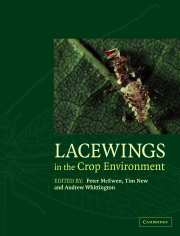Book contents
- Frontmatter
- Contents
- List of contributors
- Preface
- PART 1 Lacewing systematics and ecology
- CHAPTER 1 Introduction to the Neuroptera: what are they and how do they operate?
- CHAPTER 2 Introduction to the systematics and distribution of Coniopterygidae, Hemerobiidae, and Chrysopidae used in pest management
- CHAPTER 3 The common green lacewing (Chrysoperla carnea s. lat.) and the sibling species problem
- CHAPTER 4 Recognition of larval Neuroptera
- CHAPTER 5 Ecology and habitat relationships
- CHAPTER 6 Natural food and feeding habits of lacewings
- CHAPTER 7 Outlines of lacewing development
- PART 2 Lacewings in crops
- PART 3 Principles
- PART 4 Case studies
- PART 5 Conclusion
- Taxonomic index
- General index
CHAPTER 7 - Outlines of lacewing development
Published online by Cambridge University Press: 04 May 2010
- Frontmatter
- Contents
- List of contributors
- Preface
- PART 1 Lacewing systematics and ecology
- CHAPTER 1 Introduction to the Neuroptera: what are they and how do they operate?
- CHAPTER 2 Introduction to the systematics and distribution of Coniopterygidae, Hemerobiidae, and Chrysopidae used in pest management
- CHAPTER 3 The common green lacewing (Chrysoperla carnea s. lat.) and the sibling species problem
- CHAPTER 4 Recognition of larval Neuroptera
- CHAPTER 5 Ecology and habitat relationships
- CHAPTER 6 Natural food and feeding habits of lacewings
- CHAPTER 7 Outlines of lacewing development
- PART 2 Lacewings in crops
- PART 3 Principles
- PART 4 Case studies
- PART 5 Conclusion
- Taxonomic index
- General index
Summary
PATTERN OF INDIVIDUAL DEVELOPMENT
Green lacewings, brown lacewings, and dustywings exhibit three larval instars. This is the standard developmental pattern of Neuroptera in which only Ithonidae differ having five stages. When the thirdinstar larva is full grown, i.e. has reached its maximal weight, it looks for a place to pupate. It then spins a cocoon by moving its anal spinneret, unwinding a whitish silk-like substance developed from modified Malpighian tubules. The motionless third-instar rests inside and is called prepupa. Pupal ecdysis is performed within the cocoon giving rise to an exarate pupa. The mature pupa (_pharate adult) emerges from the cocoon through a small round cap broken with its strong mandibles. It then urgently climbs up a vertical substrate to moult into an adult. After full completion, the new adult drains off the frass accumulated during the preimaginal life (see Chapter 6, this volume). Some days later, conditional on adequate feeding, sexual maturity is attained, pairing occurs and the female begins to oviposit.
EMBRYONIC DEVELOPMENT
Embryonic development is not unusual in lacewings. Its duration varies for different species (Tables 7.1 and 7.2); for instance, incubation lasts 12 and 6 days at 21°C in Micromus paganus and Hemerobius nitidulus, respectively. It also varies with temperature, from 13 to 2.5 days in Chrysoperla carnea between 15°C and 35°C. As far as is known, embryos develop more slowly in coniopterygids than in green and brown lacewings, commonly requiring more than two weeks to hatch.
The weight of eggs during embryogenesis regularly decreases as a linear function of total duration.
- Type
- Chapter
- Information
- Lacewings in the Crop Environment , pp. 130 - 154Publisher: Cambridge University PressPrint publication year: 2001
- 10
- Cited by



